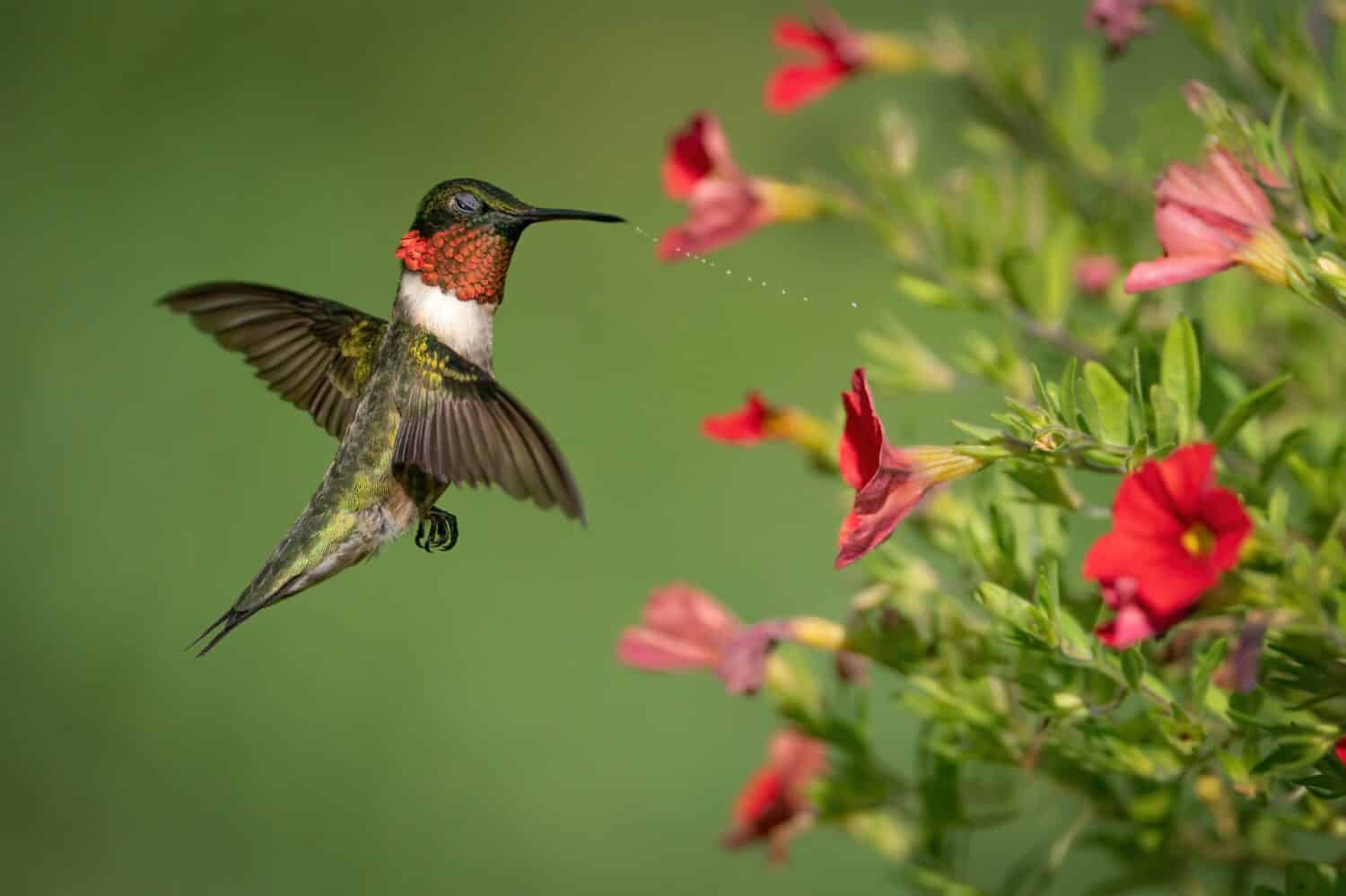Of all the 350 species of hummingbirds found in North America, the only one you’ll find in Pennsylvania is the ruby-throated hummingbird. This tiny and beautiful bird comes east to breed, then heads to Mexico, Central America or the Caribbean in the fall. Incredibly, it often makes the journey nonstop.
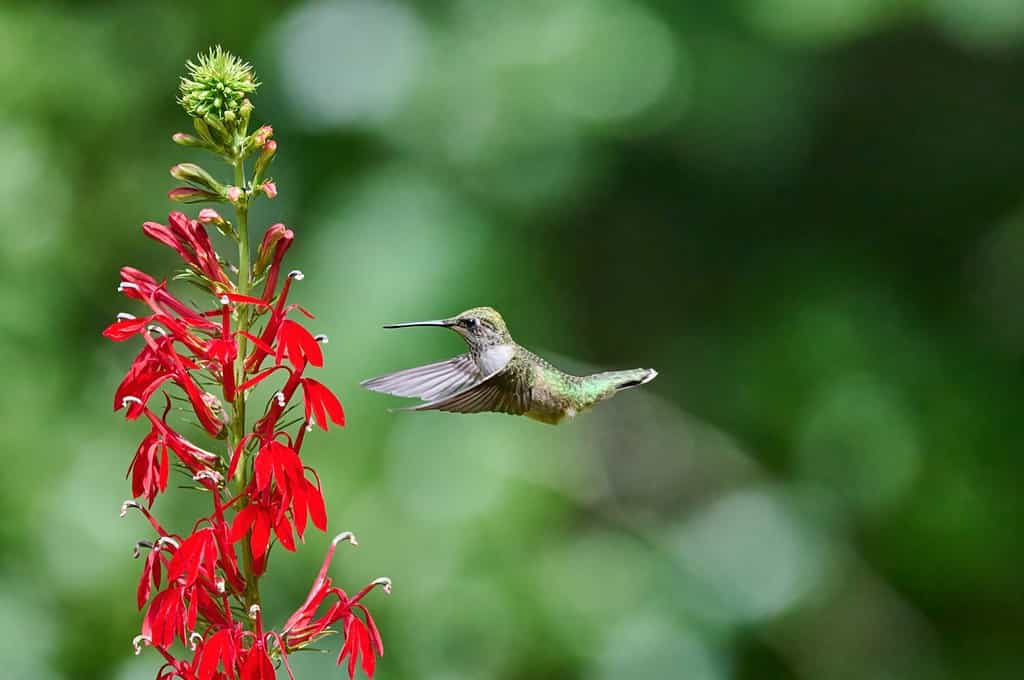
The ruby-throated
hummingbird
prefers tubular red flowers in Pennsylvania.
©Patrick Jennings/Shutterstock.com
What It Looks Like
This little bird, whose scientific name is Archilochus colubris, is between 2.8 to 3.5 inches in length, weighs between 0.07 to 0.21 ounces and has a 3.1 to 4.3 inch wingspan. Females are a little bigger than males. The bill is long and rather needlelike and contains a very long tongue that helps the birds sip nectar from their favorite flowers. The feathers on their heads and backs are green, with a metallic sheen. Their bellies are grayish white and their wings are almost black. Males have forked tails that appear violet while the female’s tail is notched. It sports green, white or black stripes on the outermost feathers. Her throat is white and may be streaked. The ruby-throated hummingbird gets its name from the adult male’s iridescently red throat patch, or gorget. The bird molts its feathers in the fall, while it’s in the warmer part of its range.
Like most hummingbirds, the ruby-throated’s feet are just about strong enough for it to perch and groom its neck and head. Its feet are too weak for it to hop about or run on the ground like other birds. The main purpose of the hummingbird’s feet is to grab hold of the stems or petals of flowers while it feeds.
How It Flies
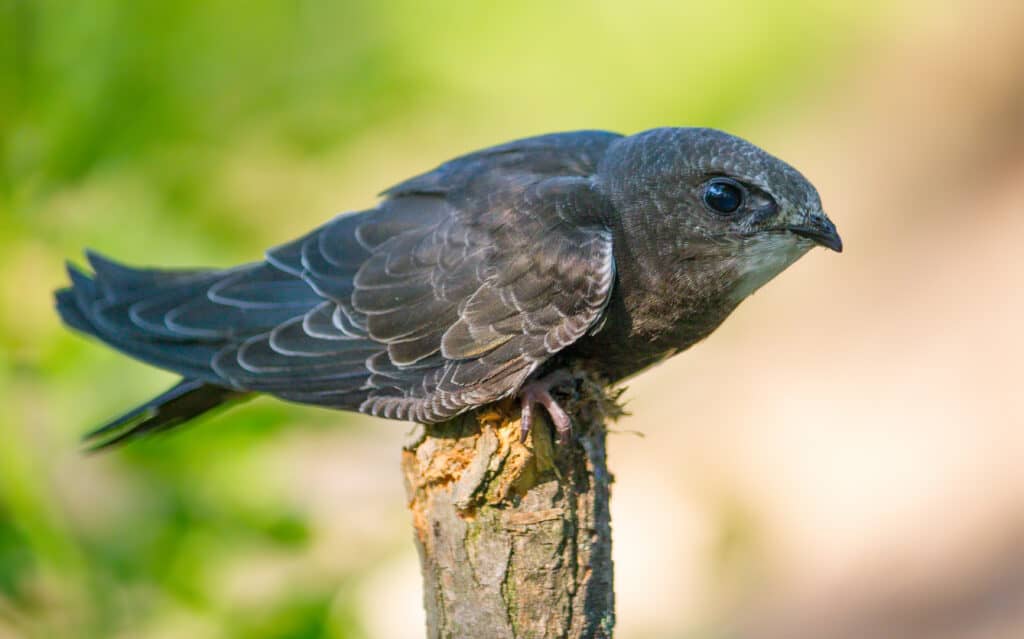
The common swift has some of the same physical adaptations of its distant cousin the hummingbird.
©Alexey Tolmachov/Shutterstock.com
Most flying birds are able to hover, even for only a few seconds, but hummingbirds are champions at hovering. This is because they have evolved physical adaptations that allow them to not only hover for a long time but to fly backwards. Usually, only insects can do this. This skill is possible because of the way the bird’s wing joint fits directly into its shoulder. One of the few birds that share this adaptation is the swift, which is a hummingbird relative. The hummingbird’s wing bone is also short and controlled by powerful flight muscles. It’s also tiny and lightweight, and its wings beat very quickly. Interestingly, like the hummingbird, the swift’s feet are only good for perching, and it also can’t walk well or hop about.
Ruby-Throated Hummingbird Behavior
Save the breeding season, ruby-throated hummingbirds are solitary and don’t care to be around each other. Males are especially aggressive toward other males they find on their territory. At first he’ll give a single call to an intruder. If that doesn’t work, he’ll raise the volume of the call. Finally, he’ll chase him off and jab him with his bill or scratch him with his claws if he catches up to him. Females will also chase away or even attack intruders.
Ruby-throated hummingbirds are active in the daytime, and spend much of the day eating. If it gets too cold, they’ll go into torpor. This is when their body temperature drops and their otherwise fierce metabolic rate, which includes a heart that beats over 1,000 times a minute, slows down. This lets the bird conserve its energy. These little birds need to conserve energy because of the long migration from their breeding to their wintering grounds and back again.
The ruby-throated hummingbird makes little cheeping sounds, usually when it senses a threat, and males make ticking sounds with their wings as they court a female. Of course, there’s the diagnostic humming sound produced by all hummingbirds. This sound is caused by the way air moves over and under the wings.
Where It’s Found In Pennsylvania
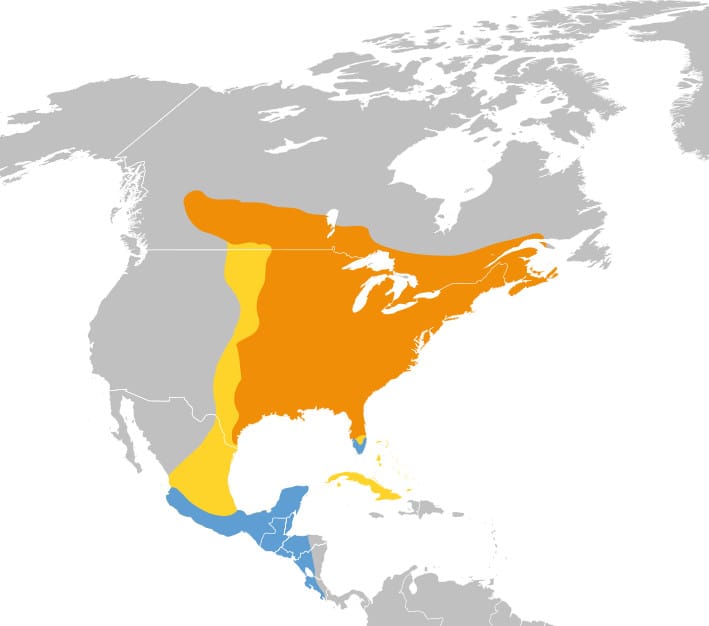
The ruby-throated hummingbird’s breeding range is orange, its migration range is yellow, and its non-breeding range is blue.
The ruby-throated hummingbird comes to the eastern United States and Canada to breed. Besides being the only hummingbird to spend any time in the northeast, its breeding range is the largest of any other hummingbird species. During this time you can find the ruby-throated hummingbird in your garden, in orchards, and in the pine forests in Pennsylvania. When it flies back to the tropics, it lives near rivers or wetlands, in fields, groves, and the edges of tropical forests.
How the Ruby-Throated Hummingbird Reproduces

The female ruby-throated hummingbird needs to feed her chicks one to three times an hour. She gets no help from the father.
©Agnieszka Bacal/Shutterstock.com
During the breeding season, whether in Pennsylvania or elsewhere, ruby-throated hummingbirds do not pair up like many other birds. They mate and then the male flies off and leaves the female to do all of the incubating of eggs and raising of chicks. But before all that, males arrive at the breeding grounds, set up a territory and drive off other males.
When the females arrive, males perform somewhat complex courtship displays to attract them. The male may puff up his throat feathers, chase the female around, or dive and do loop-de-loops above her head. If she’s interested, she’ll make a sound like a “mew” drop her wings and raise her tail. The male mates with her, then leaves. Males can mate with a number of females and females can mate with a number of males.
The Single Mom
After this, the female builds the nest in a tree or a shrub in a place where it’s hard to find. She makes it out of plant material and even spider webs and fortifies it with lichens. Then she’ll lay one, two or three eggs and incubate them between 10 and 14 days. The chicks are helpless when they hatch, but they’re ready to fledge when they’re 18 to 22 days old. Their mother feeds them for a few more days before they’re on their own. She can feed them as much as three times an hour. She gives them insects, worms and other small invertebrates as nectar alone is not enough to sustain them. Despite the energy involved in this, a ruby-throated hummingbird can raise three broods a year.
The chicks are ready to reproduce themselves when they’re about a year old. Hummingbirds live between five and nine years, and males do not live as long as females. Biologists believe this might be due to the sheer amount of energy they have to burn during the breeding season and their migration back to the tropics.
Population
Conservationists believe that were are about 34 to 36 million ruby-throated hummingbirds just in their breeding area as of 2021. This makes it the most common of all hummingbirds that live in North America. Because of this, the ruby-throated hummingbird’s conservation status is least concern.
The Plants It Loves

The tubular flowers of the trumpet honeysuckle, which is found in Pennsylvania, evolved to attract pollinators like hummingbirds.
©shepherdsatellite/Shutterstock.com
Ruby-throated hummingbirds are attracted to flowers that come in shades of red, orange or vivid pink. This is why so many hummingbird feeders have these colors. They also prefer flowers that are tubular and can accommodate the bird’s long tongue. The flowers also benefit as the hummingbirds pollinate them. Hummingbirds also snatch insects out of the air or pick them off of plants or even from spider’s webs. Flowers found in Pennsylvania that are visited by hummingbirds include:
- Trumpet creeper
- Columbine
- Trumpet honeysuckle
- Cardinal flower
- Catchfly
- Jewelweed
Ruby-throated hummingbirds need to eat twice their weight in nectar or insects every day to stay active.
Predators
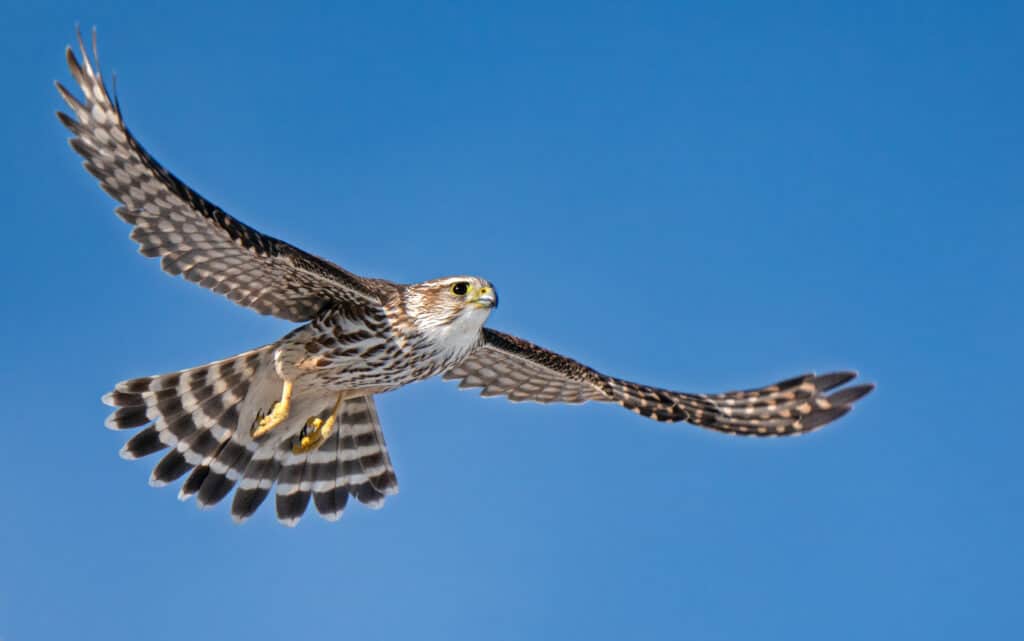
A merlin might be nimble enough to catch a ruby-throated hummingbird.
©Rob Palmer Photography/Shutterstock.com
An airborne ruby-throated hummingbird might be simply too quick and agile to be caught by most predators. However, they can be picked off while they’re asleep, looking for food, mating, incubating or brooding. Fellow birds that like to eat hummingbirds include kestrels, kites, sharp-shinned hawks and small raptors such as merlins. Shrikes also take hummingbirds as do large spiders, large dragonflies, blue jays, bats, cats, rodents and crows. Indeed, many animals that eat insects will make a meal of the tiny ruby-throated hummingbird.
Thank you for reading! Have some feedback for us? Contact the AZ Animals editorial team.

